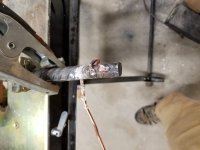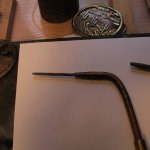I think I'd use a normal grounding clamp .... of the screw clamp type that is commonly used to connect copper ground wire to the grounding rods for household current. Home Depot...I think that would stand a better chance of surviving long enough to pass the high current in a lightning strike. Corrosion and conductivity reduction probably don't mean much to a bolt of lightning that has just jumped a mile through atmosphere.
However, if you prefer to use TIG it won't be a problem. Copper welds to steel fairly well. No solder needed. You may find that using an intermediate bronze or copper rod in your other hand will help the weld. Use the heat of TIG arc just as you would use an acetylene torch, NOT letting the flame or arc ever touch the area you are welding until the weld is done and it is time to add a little heat to the surface to smooth things up.
I've not done large silver solder (silver brazing) joints like you propose, but have silver soldered copper to steel. It's a natural easy joint. If I was dead set on using silver bearing solder like you are suggesting, then I'd clean and prep the joint, coat it with flux and wind the joint with some of the silver soldering wire. Then strike an arc an inch away from the joint and let the heat flow to the joint. That way you get clean heat to do the work. Oh, and have a piece of silver solder in your other hand to stir the joint as the metals begin to flow.
Naturally it makes sense to practice first.
good luck,
rScotty - ex K5EZK


